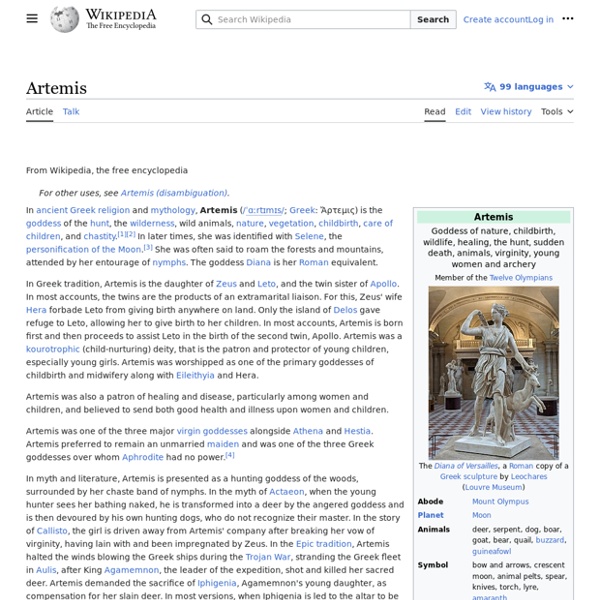Diana
From Wikipedia, the free encyclopedia Jump to navigationJump to search Diana most commonly refers to: Places and jurisdictions[edit] Africa[edit]
Sasanian Empire
last Persian empire before the rise of Islam The Sasanian Empire during Late Antiquity is considered to have been one of Iran's most important, and influential historical periods and constituted the last great Iranian empire before the Muslim conquest and the Islamization of Iran.[17] In many ways, the Sasanian period witnessed the peak of ancient Iranian civilisation. The Sasanians' cultural influence extended far beyond the empire's territorial borders, reaching as far as Western Europe,[18] Africa,[19] China and India.[20] It played a prominent role in the formation of both European and Asian medieval art.[21] Much of what later became known as Islamic culture in art, architecture, music and other subject matter was transferred from the Sasanians throughout the Muslim world.[22]
Apollo
Apollo (Attic, Ionic, and Homeric Greek: Ἀπόλλων, Apollōn (GEN Ἀπόλλωνος); Doric: Ἀπέλλων, Apellōn; Arcadocypriot: Ἀπείλων, Apeilōn; Aeolic: Ἄπλουν, Aploun; Latin: Apollō) is one of the most important and complex of the Olympian deities in classical Greek and Roman religion and Greek and Roman mythology. The ideal of the kouros (a beardless, athletic youth), Apollo has been variously recognized as a god of light and the sun, truth and prophecy, healing, plague, music, poetry, and more. Apollo is the son of Zeus and Leto, and has a twin sister, the chaste huntress Artemis. Apollo is known in Greek-influenced Etruscan mythology as Apulu. Etymology
Facts and Information on Greek Goddess Artemis
Greek Goddess of the Hunt, Forests and Hills, the Moon, Archery Artemis is known as the goddess of the hunt and is one of the most respected of all the ancient Greek deities. It is thought that her name, and even the goddess herself, may even be pre-Greek. She was the daughter of Zeus, king of the gods, and the Titaness Leto and she has a twin brother, the god Apollo. Not only was Artemis the goddess of the hunt, she was also known as the goddess of wild animals, wilderness, childbirth and virginity. Also, she was protector of young children and was know to bring and relieve disease in women.
Leto
Greek mythological figure and mother of Apollo and Artemis The island of Kos is claimed to be her birthplace. However, Diodorus, in 2.47 states clearly that Leto was born in Hyperborea and not in Kos.[2] In the Olympian scheme, Zeus is the father of her twins,[3] Apollo and Artemis, which Leto conceived after her hidden beauty accidentally caught the eye of Zeus. Classical Greek myths record little about Leto other than her pregnancy and search for a place where she could give birth to Apollo and Artemis, since Hera in her jealousy caused all lands to shun her.
Carus
Augustus Carus (Latin: Marcus Aurelius Carus Augustus;[1][2] c. 222 – July or August 283) was Roman Emperor from 282 to 283, and was 60 at ascension. During his short reign, Carus fought the Germanic tribes and Sarmatians along the Danube frontier with success. He died while campaigning against the Sassanid Empire, probably of unnatural causes, as he was reportedly struck by lightning. He was succeeded by his sons Carinus and Numerian, creating a dynasty which, though short-lived, provided further stability to the resurgent empire. Biography[edit]
Hephaestus
Greek god of blacksmiths As a smithing god, Hephaestus made all the weapons of the gods in Olympus. He served as the blacksmith of the gods, and was worshipped in the manufacturing and industrial centres of Greece, particularly Athens.
Myths, Symbols, & Meaning
Artemis, in Greek religion, the goddess of wild animals, the hunt, and vegetation, and of chastity and childbirth; she was identified by the Romans with Diana. Artemis was the daughter of Zeus and Leto and the twin sister of Apollo. Among the rural populace, Artemis was the favourite goddess.
Jupiter
Fifth planet from the Sun in the Solar System Formation and migration Astronomers have discovered nearly 500 planetary systems with multiple planets.
Diocletian
Augustus of the Eastern Roman Empire Diocletian separated and enlarged the empire's civil and military services and reorganized the empire's provincial divisions, establishing the largest and most bureaucratic government in the history of the empire. He established new administrative centres in Nicomedia, Mediolanum, Sirmium, and Trevorum, closer to the empire's frontiers than the traditional capital at Rome. Building on third-century trends towards absolutism, he styled himself an autocrat, elevating himself above the empire's masses with imposing forms of court ceremonies and architecture.



